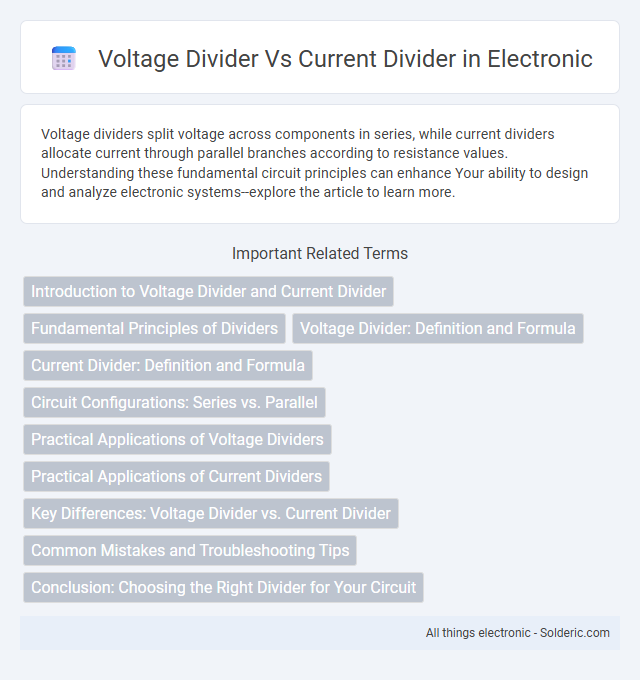Voltage dividers split voltage across components in series, while current dividers allocate current through parallel branches according to resistance values. Understanding these fundamental circuit principles can enhance Your ability to design and analyze electronic systems--explore the article to learn more.
Comparison Table
| Aspect | Voltage Divider | Current Divider |
|---|---|---|
| Definition | Series resistors dividing input voltage into fractions. | Parallel resistors dividing input current into parts. |
| Configuration | Resistors connected in series. | Resistors connected in parallel. |
| Output Parameter | Voltage across a resistor. | Current through a resistor. |
| Formula | V_out = V_in x (R_2 / (R_1 + R_2)) | I_R = I_in x (R_total / R) |
| Purpose | Obtain specific voltage levels. | Split current among branches. |
| Application | Voltage sensing, biasing circuits. | Current sensing, load sharing. |
| Key Parameters | Resistor values (R_1, R_2), input voltage V_in. | Resistor values in parallel, input current I_in. |
Introduction to Voltage Divider and Current Divider
Voltage divider and current divider are fundamental circuits used to control voltage and current in electronic systems. A voltage divider splits the input voltage into smaller voltages based on resistor ratios, while a current divider distributes the input current among parallel branches according to their resistances. Understanding these concepts helps you design circuits with precise voltage and current levels for various applications.
Fundamental Principles of Dividers
Voltage dividers operate based on the principle of distributing voltage proportionally across series resistors, adhering to Ohm's Law and Kirchhoff's Voltage Law. Current dividers, on the other hand, split current among parallel branches according to their conductances, following Kirchhoff's Current Law. Understanding these fundamental principles helps you design circuits that efficiently control voltage or current levels for various electronic applications.
Voltage Divider: Definition and Formula
A voltage divider is an electrical circuit that reduces voltage to a desired level using two resistors connected in series, with the output voltage taken across one resistor. The formula for the output voltage \( V_{out} \) is given by \( V_{out} = V_{in} \times \frac{R_2}{R_1 + R_2} \), where \( V_{in} \) is the input voltage, and \( R_1 \) and \( R_2 \) are the resistor values. Understanding this formula allows you to design precise voltage levels for your electronic circuits efficiently.
Current Divider: Definition and Formula
A current divider is a circuit configuration that splits the input current into multiple branches based on their resistances, commonly used in parallel resistor networks. The current through a particular branch \( I_n \) is determined by the formula \( I_n = I_{total} \times \frac{R_{total}}{R_n} \), where \( I_{total} \) is the total current entering the parallel network, \( R_n \) is the resistance of the branch, and \( R_{total} \) is the equivalent resistance of the parallel combination. This principle allows precise control of current distribution in complex electrical circuits, ensuring efficient design and analysis.
Circuit Configurations: Series vs. Parallel
Voltage dividers are configured in series circuits where resistors or components are connected end-to-end, allowing you to tap a portion of the input voltage across a specific resistor. Current dividers, on the other hand, use parallel configurations where multiple resistors share the same voltage but split the input current based on their resistance values. Understanding these distinct circuit arrangements helps optimize your electrical designs for voltage or current control applications.
Practical Applications of Voltage Dividers
Voltage dividers are widely used in sensor signal conditioning to scale down high voltages to levels compatible with microcontroller ADC inputs, ensuring accurate readings and protecting hardware. They play a critical role in biasing transistor amplifiers and setting reference voltages in analog circuits, enabling stable and predictable device operation. Voltage dividers also facilitate adjustable voltage outputs in variable power supplies and control circuits, enhancing versatility in electronic system design.
Practical Applications of Current Dividers
Current dividers are essential in practical applications such as controlling the current flow in parallel circuits, allowing precise distribution of current to multiple components like LEDs or sensors. They enable efficient current management in analog signal processing and power distribution systems, ensuring that each branch receives the appropriate current without affecting overall circuit performance. Your electronic designs benefit from current dividers by improving reliability and protecting sensitive components from excess current.
Key Differences: Voltage Divider vs. Current Divider
Voltage dividers split voltage across series resistors while current dividers distribute current through parallel resistors, essential for controlling signal levels and current flow in circuits. Voltage dividers follow the ratio of resistor values to determine output voltage, whereas current dividers use resistor values inversely to allocate current. Your choice depends on whether you need to scale voltage or manage current in an electrical design.
Common Mistakes and Troubleshooting Tips
Common mistakes in voltage divider circuits include incorrect resistor values leading to inaccurate output voltage and neglecting the load effect, which can alter the voltage division ratio. In current divider circuits, errors often arise from miscalculating branch resistances or failing to account for parallel branch interaction, causing unexpected current distribution. To troubleshoot, verify resistor values with a multimeter, ensure proper loading conditions, and simulate circuits with tools like SPICE to predict behavior before implementation.
Conclusion: Choosing the Right Divider for Your Circuit
Voltage dividers are ideal for applications requiring precise voltage levels from a higher voltage source, utilizing series resistors to proportionally reduce voltage. Current dividers suit circuits needing specific current distribution among parallel branches, relying on parallel resistors to control current flow. Selecting the right divider depends on whether voltage regulation or current allocation is the primary design goal in the electrical circuit.
voltage divider vs current divider Infographic

 solderic.com
solderic.com